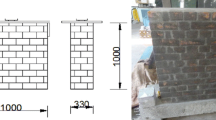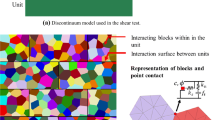Abstract
The analysis of the mechanical behaviour of masonry structures is based on the assumption that this material does not withstand tension. In this field many researchers are studying how to refine analytical and experimental procedures to obtain a more accurate correspondence between the real behaviour and the simulated one.
However, this hypothesis cannot explain the masonry strength with respect to dynamic and seismic load conditions, which cause tensile stresses and dilating strains in masonry structures.
The aim of this work is to give a complete set of experimental results in order to determine the mechanical properties of brick masonry. In particular, an extensive experimental programme was carried out to characterise the mechanical and structural behaviour of masonry composite in compression, along both the material directions, and in tension, along the horizontal mortar joint direction.
Tensile properties in particular were estimated by means of four-point bending (FPB) tests owing to the lack of a standard tensile test and because bending tests are considered to be reliable indirect tensile ones and easy to carry out.
The experimental results obtained using this testing procedure highlighted the behaviour of a bimodular material when subjected to tensile stresses, and these were then analysed by means of fracture mechanics theory to estimate the masonry toughness and stress intensity factor as further material characteristics.
Résumé
L’analyse du comportement mécanique des structures des ouvrages en maçonnerie se fonde sur la supposition que le matériel ne supporte pas les tensions de traction. Dans ce domaine, beaucoup de chercheurs sont en train d’étudier des procédés analytiques et expérimentaux raffinés pour obtenir une meilleure correspondance entre le comportement réel et les simulations analytiques-numériques.
D’autre part, cette hypothèse ne peut pas expliquer les capacités de résistance des ouvrages en maçonnerie par rapport aux actions dynamiques ou sismiques qui provoquent des tensions et déformations d’ouvrages en maçonnerie.
Ce travail a pour but de fournir une revue complète des résultats expérimentaux afin de déterminer les caractéristiques des ouvrages en maçonnerie de briques pleines. En particulier, un vaste programme a été actualisé pour caractériser l’attitude mécanique et structurale du composite en maçonnerie, en compression, le long des deux directions matérielles, et en tension, le long de la direction des bains de mortier horizontaux.
On a évalué les caractéristiques en tension au moyen d’essais de flexion à quatre points (FPB), faute d’essai de tension directe standard et aussi car les essais de flexion sont considérés comme des essais de tension indirecte fiables et facilement exécutables.
Les résultats expérimentaux obtenus ont mis en évidence le comportement bimodulaire des ouvrages en maçonnerie, et ont, par la suite, été analysés à travers la théorie de la mécanique des fractures pour évaluer aussi bien la ténacité que le facteur d’intensité de contrainte comme paramètres caractéristiques supplémentaires.
Similar content being viewed by others
References
Anand, S. C. and Rahman, M. A., ‘Accurate estimation of interface shear stresses in masonry walls’,J. Struct. Eng. 120 (3) (March, 1994) 998–1015.
Anderson, D. L. and Priestley, M. J. N., ‘In plane shear strength of masonry walls’, Proc. of the 6th Canadian Masonry Symposium, Saskatoon, Saskatchewan, Canada, June, 1992, 657–662.
Angelillo, M. and Olivito, R. S., ‘Experimental analysis of masonry panels loaded horizontally in plane’,Masonry International 8 (3) (April, 1995) 91–100.
Bocca, P., Carpinteri, A. and Chiaia, B. ‘On the size-dependence of the fracture properties of brick masonry walls’,J. of Engineering Mechanics (ASCE) 123, (8) (1996) 816–822.
Bocca, P., Carpinteri, A. and Valente, S., ‘Fracture mechanics of brick masonry: size effect and snap-back analysis’,Mater. Struct. 22 (131) (1989) 364–373.
Carpinteri, A. and Chiaia, B., ‘Size effect on concrete fracture energy: dimensional transition from order to disorder’,Mater. Struct. 28, (182) (1995) 435–443.
Fanella, D. and Krajcinovic, D., ‘Continuum damage mechanics of fiber reinforced concrete’,J. of Eng. Mech. 111 (8) (August, 1985) 995–1009.
Gao, Y. C., ‘Damage modelling of fiber reinforced composites’,Theoretical and Applied Fracture Mechanics 11 (1989) 174–185.
Hashin, Z. ‘Analysis of composite materials’,J. of Appl. Mech. 50 (1983) 481–505.
Hendry, A. W., ‘Structural brickworks’ (The Macmillan press Ltd., London, U. K., 1981).
Lofti, H. R. and Shing, P. B., ‘Interface model applied to fracture of masonry structures’,J. Struct. Eng.,120 (1) (January, 1994) 63–80.
Olivito, R. S. and Stumpo, P., ‘Fibre reinforced mortar for the repairing of brick masonry subjected to tensile stresses’, Proc. of the 25th AIAS Nat. Conf., Int. Conf. on Material Engineering, Gallipoli (LE), 4–7 September, 1996, 1177–1184.
Pietruszczak, S. and Niu, X., ‘A mathematical description of macroscopic behaviour of brick masonry’,Int. J. of Solids & Structures,29, (5) (1992) 531–546.
Shah, S. P. and Slate, F. O. ‘Internal microcracking, mortaraggregate bond and the stress-strain curve of concrete’, Proc. of Int. Conf. on the Structure of Concrete, Session B, 1965, 65–92.
RILEM Technical Committee 50. ‘Determination of the fracture energy of mortar and concrete by means of three-point bending tests on notched beams’,Mater. Struct. 18 (106) (1985) 287–290.
Author information
Authors and Affiliations
Rights and permissions
About this article
Cite this article
Olivito, R.S., Stumpo, P. Fracture mechanics in the characterisation of brick masonry structures. Mat. Struct. 34, 217–223 (2001). https://doi.org/10.1007/BF02480591
Received:
Accepted:
Issue Date:
DOI: https://doi.org/10.1007/BF02480591




